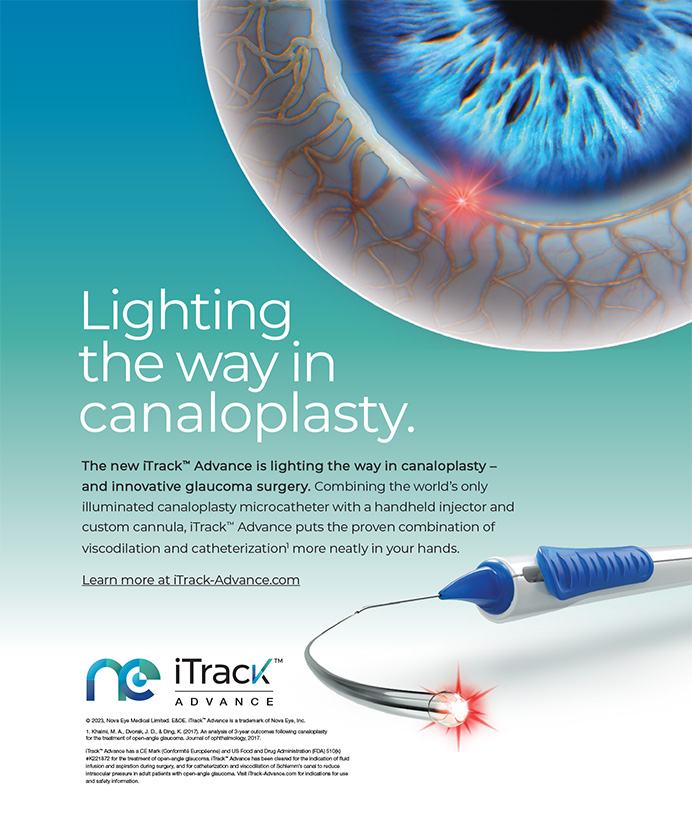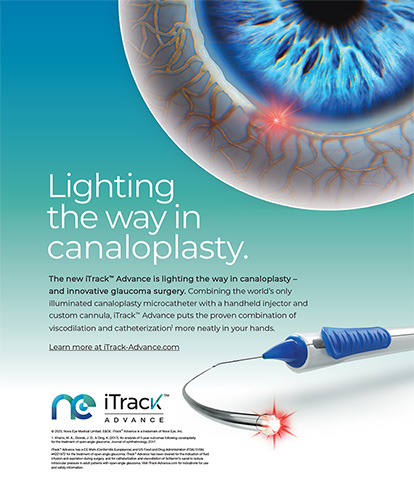At its core, the formula necessary for determining IOL power following cataract surgery relies on the axial length of the eye and the cornea's total dioptric power. When calculating IOL power for a patient who previously underwent corneal refractive surgery, the resulting values are inaccurate if postsurgical keratometric values are used. This inaccuracy is due to two reasons: (1) there is a corneal curvature discrepancy, and (2) there is a change in the cornea's index of refraction.
CORNEAL POWER/SHAPE
Identifying Distortions
The total corneal power is the sum of the anterior power (convex lens) and the posterior power of the cornea (concave lens). In LASIK and PRK, there is a change in the radius of the anterior cornea's curvature, but the posterior cornea is relatively unchanged. Traditional and simulated keratometry from corneal topography estimate corneal power by measuring it around a central 3.2-mm ring on its anterior surface. For a normal prolate cornea, calculation of the central power is accurate because the sampling location (3.2 mm) has a power similar to the central power. Following keratorefractive surgery, this relationship is altered, and the sampling location may have a power that is steeper than the center (for a myopic ablation), resulting in a calculated power that is higher than in reality (ie, the cornea is really flatter than indicated and so the power of an IOL is too low, resulting in a hyperopic surprise after cataract surgery) (Figure 1). The opposite is true for a hyperopic ablation.
Instruments that measure both anterior and posterior curvature, such as the Orbscan topographer (Bausch & Lomb, Rochester, NY) or Pentacam (Oculus, Inc., Lynnwood, WA), may decrease these errors of determining the true corneal power. Errors in keratometry may have other implications as well, however.
Formulae for IOL Positioning
Third-generation IOL formulae (ie, SRK/T, HofferQ, Haigis, Holladay 2) account for the position of the lens relative to the cornea (also known as the effective lens position) to increase accuracy. The effective lens position is accomplished by measuring anterior chamber depth (Haigis) or by estimating anterior chamber depth from the keratometry measurements (SRK/T, HofferQ).1-3 If keratometry measurements are inaccurate, that error is propagated into the calculations for effective lens position, further compounding the problem.
Index of Refraction
In addition, the altered index of refraction in a postrefractive surgery cornea is another source of error. Standard keratometers/topographers rely on an index of refraction of the cornea of 1.3775 to convert radius of curvature data into dioptric power. After keratorefractive surgery, the cornea's index of refraction is altered, introducing further error.
ACCOUNTING FOR ERRORS
Multiple methods or "fudge factors" have been introduced to account for these variations. At last count, 25 different methods have been published, each showing some promise, but with only limited testing.4 Some processes require specialized equipment not readily available to most cataract surgeons.5-7 A number of approaches involve performing retinoscopy or refraction intraoperatively.8 But most techniques attempt to improve outcomes by looking at pre- and postoperative data for the keratorefractive procedure. Some methods require preoperative keratometry, which is not always readily available.9-13 Others ignore preoperative keratometry and focus on change in refraction.14-18 Although all of theses tactics were tested individually in a clinical setting and against other approaches, none of them received large-scale widespread testing.
CALCULATORS
Numerous individuals have attempted to simplify the calculation process by creating Excel (Microsoft Corp., Redmore, WA) spreadsheets, which have been propagated over the Internet and through various list servers. My colleagues and I started with an Excel spreadsheet. We soon found that although the average ophthalmologist understands the basic reasoning behind the various methods, most were only interested in the knowing the power of the IOL needed for the desired postoperative refraction. We proceeded to create an online calculator to simplify the process. Currently, to perform multiple calculations simultaneously, one need only visit iol.ocularmd.com.
This calculator is a work in progress. At present, 10 methods are implemented; there are four that require preoperative keratometry and six that do not (Table 1). IOL powers for a target refraction (default is emmetropia) are calculated using the corrected SRK/T and Haigis formulae, with the exception of the Aramberri double-K method, which only uses the SRK/T formula and the Walter method, which is currently only implemented for emmetropia.2-15 An average of the IOL powers for each approach is computed and displayed at the bottom of the output chart (Figure 2). This display gives users the advantage of comparing the methods to look for variability and possible outliers.
The real advantage of using our calculator is the possibility of gathering data for analysis. As part of the program, you have the option of entering your e-mail address. By doing so, you agree to participate in postoperative outcomes analysis and consent to the storage of your data. Three months after using the calculator, you will receive an e-mail requesting post-IOL implantation data for your patient (identified only by initials), which will be compiled and analyzed. This data gathering will provide the opportunity for large-scale testing of each methods.
Other publicly available calculators are also under development. An Alcon Laboratories, Inc. (Fort Worth, TX)-sponsored IOL calculator is currently available on the ASCRS Web site.19 Although this calculator only uses a handful of methods, it is useful for surgeons who have access to specialized equipment, such as the Pentacam, Eyesys (Eyesys Technologies, Inc., Houston, TX), or Humphrey Atlas (Carl Zeiss Meditec, Inc., Dublin, CA).
Accuracy in calculating the true corneal power after keratorefractive surgery will undoubtedly improve. Until then, calculators such as the ones mentioned herein may make life simpler for cataract surgeons as the number of postrefractive surgery cataract patients increases.
Dennis H. Goldsberry, MD, PE, is in private practice with Ophthalmology Associates in Richardson, Texas. The free calculator presented herein is available on Dr. Goldsberry's personal Web site: www.OcularMD.com. Dr. Goldsberry may be reached at (972) 690-1922; ocularmd@hotmail.com.
Parag A. Majmudar, MD, is an Associate Professor of Ophthalmology at Rush Medical College in Chicago, Illinois, and is in private practice with Chicago Cornea Consultants, Ltd. Dr. Majmudar acknowledged no financial interest in any product or company mentioned herein. Dr. Majmudar may be reached at (847) 882-5900; pamajmudar@chicagocornea.com.


